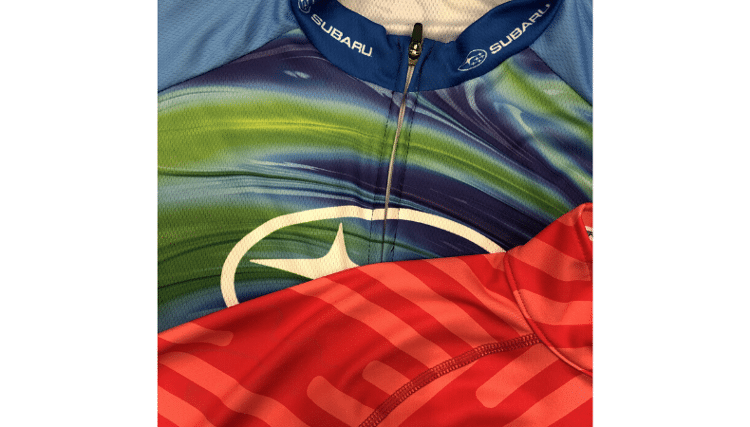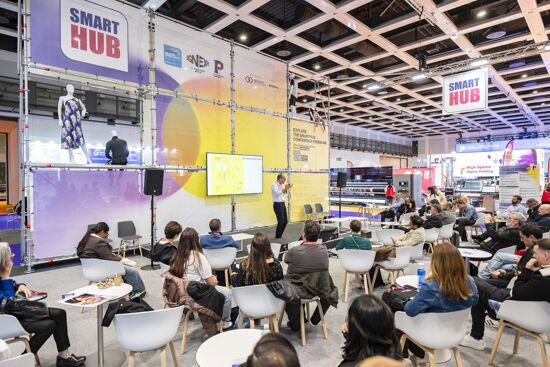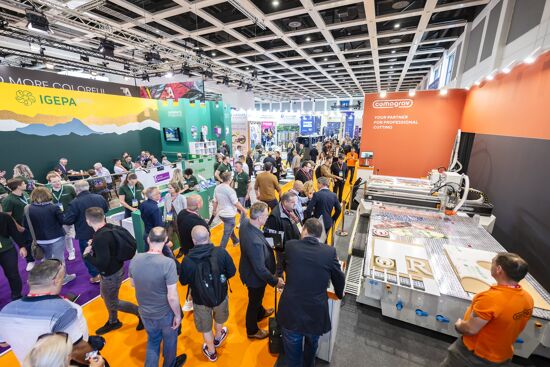The What, Why and How of New Opportunities in Digital Textile Printing

FESPA's Textile Ambassador, Debbie McKeegan discusses her experience at the Digital Textile Printing Conference on 22nd October 2019 as well as the new opportunities available in the digital textile printing industry.
As the Textile industry flexes to meet the demands of a new generation of consumers and embraces a new suite of disruptive manufacturing technologies, it can often be difficult for professionals and practitioners within the industry to keep up with the speed of technical change and to decipher new business opportunities.
.jpg?lang=en-GB)
Caption: The Digital Textile print sector is evolving at a rapid pace, to meet the needs of the textile supply chain and offer a new era of data driven transparency, alongside efficient and sustainable manufacturing technologies.
The Digital Textile Print Conference held on the 22nd October at the Kay Bailey Hutchison conference centre, Dallas, prior to the Printing United exhibition offered a curated agenda that brought together industry professionals, expert practitioners and Digital Textile technology providers from across the globe for an afternoon of Insight, Talk sessions, Industry showcases, and group discussion.
The Digital Textile print sector is evolving at a rapid pace, to meet the needs of the textile supply chain and offer a new era of data driven transparency, alongside efficient and sustainable manufacturing technologies. As a sector the Textile Industry offers a vast eco-system that spans multiple products, market sectors and seamless, integrated technologies worldwide. Organised by Ron Gilboa, of KeyPoint Intelligence, the conference offered a window of excellence into Digital Textile production for existing practitioners and delegates exploring new business opportunities.
Textiles and Wide Format Graphics are very different eco-systems, and whilst they do now share many of the same digital printing technologies as a means of manufacture, each has a unique set of requirements and technical specifications. The Textile marketplace offers a myriad of new opportunities for convergence; however, the transition demands a whole host of essential skills, and a deep understanding and appreciation of the textile sector whose clients host different requirements.
.jpg?lang=en-GB)
Caption: Lily Hunter of Roland DGA was joined in conversation with Jeremy DeBoer of Savicustoms to provide an insight into customised manufacturing utilising dye sublimation technologies for polyester sportswear.
For the first presentation, Mike Wozny of EFI was joined in conversation with a customer Dave Brewer from Image Options, for a lively discussion on the opportunities that Digital Textiles offer within the wide format space. In collaboration with Dave, a specialist print service provider the audience discovered why colour management is critical, the importance of ink technology for radiance and UV light performance, the true value of consistent print quality, and how sourcing the correct textile fabrics requires skill and an appreciation of textile technology.
Sustainability is a key factor for both the printed graphics textile supplier and the consumer, and whilst the industry is keen to adopt best practice and speed up the recycling process, during this debate many delegates in the audience expressed their frustration at the lack of recycling resources available, this is a worldwide issue. If we are to move forward towards circular design and sustainable practice as an industry, the infrastructure and availability of recycling services is critical.
Lily Hunter of Roland DGA was joined in conversation with Jeremy DeBoer of Savicustoms to provide an insight into customised manufacturing utilising dye sublimation technologies for polyester sportswear. Providing customised production of sports garments with no minimum order adds an administrative burden on a small business and requires automated process, and so to facilitate this Jeremy DeBoer built his own customised order management system.
As the demand for customised manufacture grows, the requirement for web-to-print software is critical. Inventory management of both consumables and client data must be electronic for both efficient manufacturing and in order to provide excellent customer service. Working with Roland print technology Savicustoms have built a successful family business supplying the demand for customised Sports apparel. It was noted that supplying sewn garments has required an in-house training program and that the recruitment of sewn skills locally is difficult. With a workforce moving into retirement it is essential that we train and encourage a new generation of sewing practitioners.
With an in-house design studio offering creativity and pre-press production skills the company have established a reputation for exceptional printed sportswear garments, delivered in record speeds, to fulfil the expectations of a loyal client base.
The Textile sector is a diverse marketplace and for the majority of printed ink jet technologies for direct to fabric applications, the fabrics need to be pre-treated prior to digital printing. Mark Sawchak of Premex and his team provide a range of pre-coated textile fabrics for digital production. With an overview of the textile workflow, supply-chain and the shift towards customisation, Mark explained the emergence of new opportunities for diversification within the textile sector, entrepreneurial business models, and why sustainability is a topic high on the industry’s agenda.
Digital technologies are disrupting the Textile space to offer a much-needed solution for an Industry that must meet the demands of the client seeking sustainable supply. Debbie McKeegan, the CEO of Texintel and the FESPA Textile ambassador presented a snapshot of the Industry, moving on to discuss the supply chain, sustainable solutions, and why we see a shift towards supply chain transparency, alongside an efficient workflow, and how we must utilise smart technologies to reach the expectations of our clients.
In doing so our industry is gradually becoming more sustainable, by using less energy, by consuming less resources and by producing less waste and by the adoption of automated, data driven technologies utilising industry i4.0.
.jpg?lang=en-GB)
Caption: Sustainability is prerequisite for the textiles of the future and all business sectors must adopt best practice, without which they will undoubtably begin to lose market share.
The growth of the Digital Textile print sector is a reflection of the tracked growth of ecommerce and a predicted rise in both global population and affluence. These factors are driving customisation and personalisation regardless of print volume and have established a digital Textile print industry that is set to dominate the printed textile marketplace in the years to come.
Sustainability is prerequisite for the textiles of the future and all business sectors must adopt best practice, without which they will undoubtably begin to lose market share. Why? Because as the global super brands pledge towards Carbon Neutrality, successful suppliers for the future must take heed and re-equip to offer sustainable textile production and transparent supply for business to thrive.
In conclusion, Ron Gilboa of Keypoint Intelligence noted that as the markets and applications for Textiles expand within wide format sector and the re-equipment of the traditional textile sectors, new opportunities abound for entrepreneurial growth. The machinery vendors within our industry now offer technologies for multiple textile applications and variable business models, tailored and built for any volume, at any speed of print meterage. As technologies develop automatic scanning devices offering machine vision will emerge to reduce waste by auto detection of defects, be that colour or head faults.
It was also noted by all vendors that to facilitate growth it is it imperative that we deliver best practice and knowledge directly to our consumers in support of the wider community.
Collaboration, certification and the implementation of standards are an essential component for the future growth of the Digital Textile Industry.
Topics
Interested in joining our community?
Enquire today about joining your local FESPA Association or FESPA Direct
Recent news

Industry Experts Explore the Evolution of Smart Manufacturing in the Textile Industry
A FESPA SmartHUB roundtable at Personalisation Experience 2025 discussed smart manufacturing's transformative impact on the textile industry. Experts highlighted the shift to on-demand customisation, driven by digital printing, data analytics, and automation. Key takeaways included enhanced machine control, significant waste reduction through intelligent software and colour management, and improved sustainability via energy efficiency and near-shoring, ensuring agility and environmental responsibility in textile production.

FESPA 2025 gathers leading visionaries from across the speciality print industry in Berlin
FESPA Global Print Expo 2025, European Sign Expo and Personalisation Experience (6 – 9 May 2025, Messe Berlin, Germany) welcomed Visionaries from across the speciality print industry to shape the future of print, develop forward-thinking business strategies, and explore innovative ways to translate emerging industry trends into tangible growth opportunities.

Exploring Cutting-Edge Textile Printing Innovation with Adobe Print Engine 7
Adobe PDF Print Engine 7, launched at FESPA Global Print 2025, significantly advances textile printing. Debbie McKeegan shares how it automates non-white substrate management and RGB colour handling, expands colour gamuts with in-RIP multicolour transparency blending, and streamlines workflows for efficiency and sustainability. This update boosts customisation, reduces waste, and positions businesses at the forefront of digital print innovation.

FESPA Global Print Expo 2025 - Overall Highlights
FESPA Global Print Expo, Europe's leading print and signage exhibition returned to Messe Berlin from 6 - 9 May 2025.